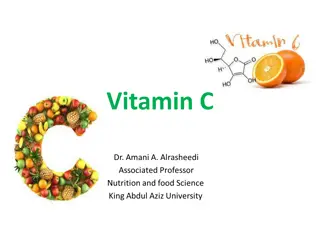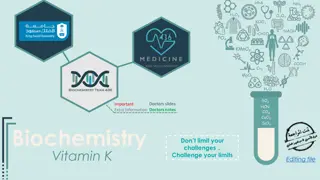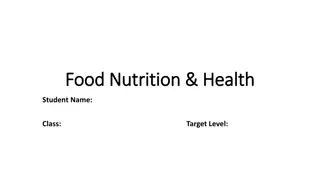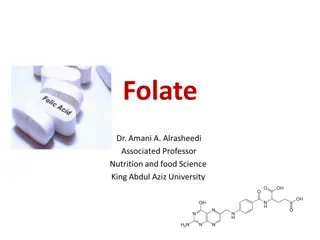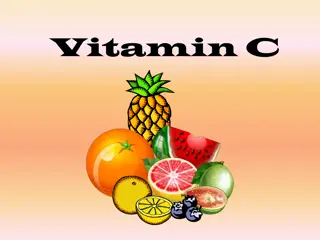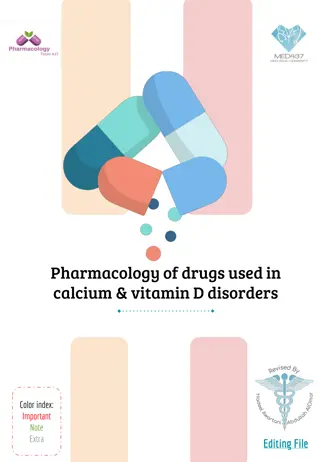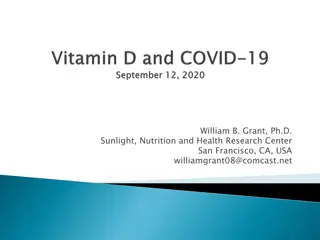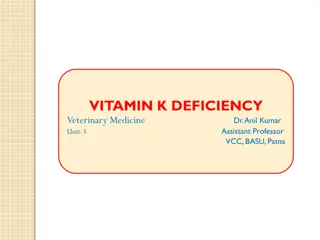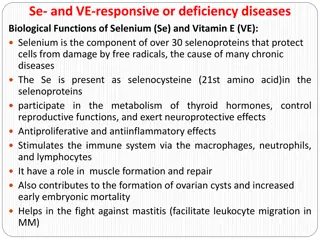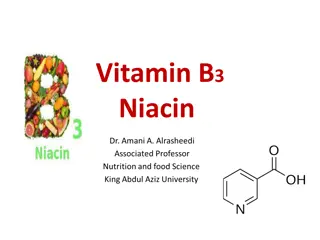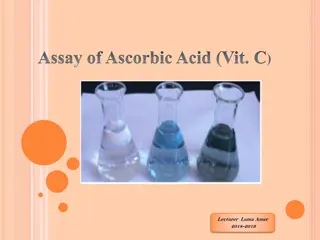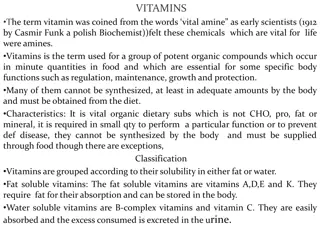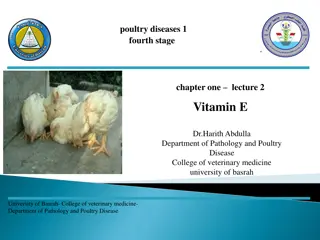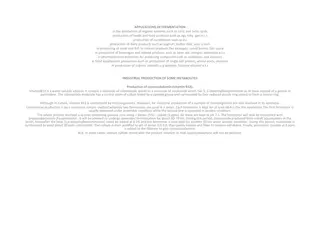Understanding Vitamin C: Functions, Sources, and History
Vitamin C, also known as ascorbic acid, is a vital water-soluble vitamin that humans must obtain through their diet as they cannot produce it internally. This article delves into the structure, metabolism, recommended daily intake, dietary sources, historical significance, and various functions of vitamin C, including its role in collagen synthesis, iron absorption, and antioxidant activity. Discover the importance of vitamin C in maintaining overall health and preventing conditions like scurvy.
Download Presentation

Please find below an Image/Link to download the presentation.
The content on the website is provided AS IS for your information and personal use only. It may not be sold, licensed, or shared on other websites without obtaining consent from the author. Download presentation by click this link. If you encounter any issues during the download, it is possible that the publisher has removed the file from their server.
E N D
Presentation Transcript
VITAMIN C Presented by Dr.N.PACKIALAKSHMI ASSISTANT PROFESSOR [DEPARTMENT OF MICROBIOLOGY] JAMAL MOHAMED COLLEGE TRICHY-620020
INTRODUCTION Vitamin C -known as ascorbic acid -is a water-soluble vitamin. Unlike most mammals, humans do not have the ability to make their own vitamin C. Therefore, we must obtain vitamin C through our diet. Fun fact: "ascorbic acid" comes from the New Latin "scorbutus" meaning scurvy!
Structure and metabolism Metabolism oxidation/reduction dehydroascorbic acid dehydroascorbate reductase glutathione (GSH) Glutamate-cysteine glycine
RDA FOR VITAMIN C 10 mg/day prevents scurvy Historic RDA s 45-70 mg (60mg in 1989), 75mg in 2000
HISTORY OF VITAMIN C 17th century sailors got scurvy on ships and ship surgeon, James Lind, prescribed lemon juice as preventative. Performed an experiment experiment that proved that lemon juice prevents scurvy. We now know today that it is because of the Vitamin C in the lemon that prevents scurvy or a vitamin c deficiency.
FUNCTIONS OF VITAMIN C Enhances absorption of iron. Reduces iron to more absorbable ferrous form. Chelates with ferrous ion to make it more soluble. Antioxidant Activity: Reacts and removes active oxygen species Pro-oxidant Activity: Reduces metals to their pro-oxidant formsn to make it more soluble
FUNCTIONS OF VITAMIN C Hydroxylation of proline and lysine post-translational reaction of procollagen Hydroxylated collagen can be cross-linked to triple helix collagen Scurvy - weak collagen Hydroxylation Reactions Involves O 2 and metal coenzyme (ferrous, cuprous) Carnitine synthesis Tyrosine synthesis & catabolism Synthesis of Neurotransmitters Dopamine Norepinephrine Serotonin Bile acid synthesis
FUNCTIONS OF VITAMIN C Synthesis of collagen, an important structural component of blood vessels, scar tissues, tendons, ligaments, and bone. Synthesis of the neurotransmitters, norepinephrine critical to brain function and are known to affect mood.
FUNCTIONS OF VITAMIN C Highly effective antioxidant protects proteins, lipids (fats), carbohydrates, and nucleic acid (DNA and RNA) from damage by free radicals. Regenerates other antioxidants such as vitamin E. Vitamin C is required for the synthesis of carnitine, a small molecule that is essential for the transport of fat to mitochondria, for conversion to energy.
DEFICIENCY OF VITAMIN C Cardiovascular Disease Stroke Cataracts Lead toxicity Scurvy
SCURVY Bleeding gums Petechiae Easy bruising Impaired wound healing and bone repair Joint pain Anemia
PEOPLE AT RISK FOR SCURY People with chronic malnutrition or those that eat less than 2 servings of fruits/vegetables per day Alcoholics Elderly Men who live alone (bachelor or widower scurvy) Children People on peculiar diets or food fads People with other medical conditions that may prevent the intake and/or absorption of vitamin C Dialysis patients Malabsorption disorders Severe dyspepsia
COMPLICATIONS Skin problems: one of the first signs of scurvy is the development of perifollicular hyperkeratotic papules, These appear as reddish/bluish bruise-like spots surrounding hair follicles. The central hairs are twisted like corkscrews that may break easily. The papules may join together to form large areas of palpable purpura or ecchymoses (bruises).
COMPLICATIONS Oral problems problems: gums may swell and become red, soft and spongy. Any slight friction may cause the gums to bleed. Often this results in poor oral hygiene and dental diseases.
COMPLICATIONS Musculoskeletal problems: bleeding in the joints causes extreme discomfort and pain. Joints may be swollen and tender and the pain can be so severe that patients cannot walk. Heart and lung problems: shortness of breath, low blood pressure, and chest pain leading to shock and death.
TREATMENT AND PREVENTION Treatment is simply with vitamin C supplements taken orally. The adult dose is 800-1000mg/day for at least 1 week, then 400mg/day until complete recovery. In the U.S., the recommended dietary allowance (RDA) for vitamin vitaminC was recently recently revised revised upward from 60 mg daily for men and women. The RDA continues to be based primarily on the prevention of deficiency disease, rather than the prevention of chronic disease and the promotion of optimum health. Infants who are being weaned from breast milk to cow's milk need a supplement containing vitamin C.
TOXICITY OF VITAMIN C UL adults: 2000mg/d Osmotic diarrhea Oxalate kidney stones Decreases uric acid reabsorption resulting in increased risk of gout Affects diagnostic tests in feces and gout fecal blood urinary glucose


